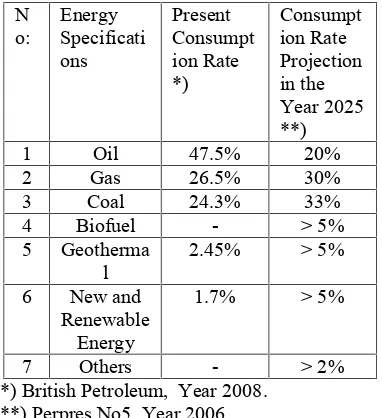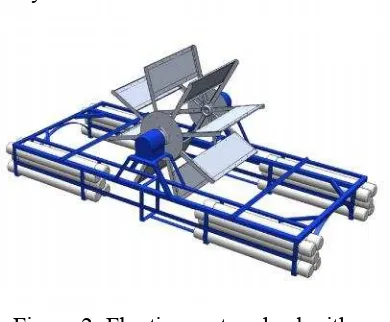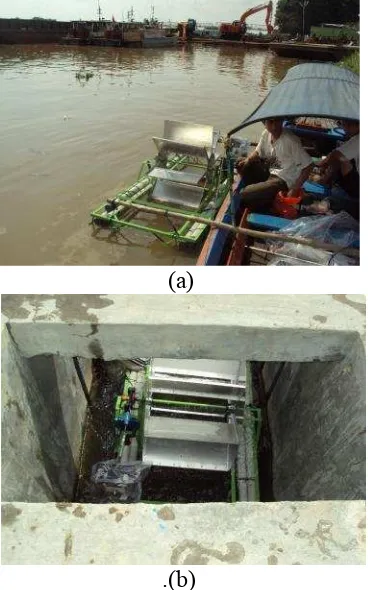Pico Hydropower Application on Tidal Irrigation Canal
Supporting The Indonesian Agricultural Activities
Case Study: Telang II - Banyuasin
Darmawi*), Riman Sipahutar*), Siti Masreah Bernas**), Momon Sodik Imanuddin**)
Author e-mail:d_bayin2009@yahoo.com
Telephone number: +62812-7886884
*) Lecturer of Mechanical Engineering of Sriwijaya University. **) Lecturer of Agriculture Faculty of Sriwijaya University
Abstract
A review of waterwheel history has conducted to evaluate the possibility and the technology development in its relation to harvest the energy from the flowing water in and out of irrigation canal regarding the tidal movement. The study has conducted at the east shore of South Sumatra. Hydro energy became a promising renewable energy in order to achieve at least 5% of total Indonesian national energy mix consumption in 2025. Tidal turbine energy is technologically potential for Indonesian future regarding the beach of 81,000 kilometers long and 20 millions hectares of tidal swamp area out of 33 millions hectares available. Mechanical torque of 30 Nm is produced by a waterwheel of 0.38 meter radius. An estimation of 60 watt at the peak of rain season could harvested from each tidal irrigation canal in Telang II. This mechanical energy is applicable to generate small quantity water pump, water aeration injector and small electric energy energy appliances.
Keyword: Hydropower, renewable energy, tidal energy, irrigation canal.
Introduction
The world electric energy production become doubled in the last decade, from 9.5 MTOe in 2001 to 19
necessity with hydropower.e.g. Brazil with 85.5% of its national capacity , Norwegia with 98.25% of national capacity and Canada with 61.12% of national capacity. (Wikipedia,2009) Hydro energy is an interesting energy resource regarding the clean and safe impact on the environment.
Indonesia is trying hard to diversify the energy consumption, concerning the pain experiences of state economic disturbances when the oil price raise. The higher the portion of oil in national energy consumption, the more the dependency of state economic on oil price. The government take some policies on the base of energy conservation, energy saving and energy diversification. In order to achieve the energy diversification target successfully, it is projected to consume energy mix as presented in Table 1, as a compulsory target. Renewable energy resources as solar energy, wave energy, tidal energy, wind energy are abundance in Indonesia regarding the geographic position across the tropic area and archipelagic islands of the country.
Hydropower is a possible energy to be developed in Indonesia regarding the huge amount of hydro energy potential. It is estimated that Indonesian hydropower potential about 75,000 MW one-third of Asian hydropower potential. (Hayes, 2004; Kamarudin, 2005). Hydropower, especially Tidal Current Turbine take special attentions for development in recent years. Tidal Current Turbines are classified as small hydropower regarding the energy produced mostly below 50 MW.
1. Greenhouse Gas Emission and Global Warming
Global warming is faced by the earth and threaten all nations on the globe. It is predicted that no nations and no countries will safe on earth when the
temperature rise and climate change affected by the global warming is out of control.
Table 1: Indonesian Energy
Consumption Rate at Present and Consumption Projections in The Year 2025
*) British Petroleum, Year 2008. **) Perpres No5, Year.2006.
The greenhouse effect is the process of absorption and emission of infrared radiation by gases in the atmosphere and warm the planet's lower atmosphere and surface. It was proposed by Joseph Fourier in 1824. (Weart, 2008).
The major greenhouse gases are water vapor, which causes about 36 70% of the greenhouse effect (Schmidt, 2005) ; carbon dioxide (CO2), which causes
9 26%; methane (CH4), which causes
4 9%; and ozone (O3), which causes
3 7%. (Russell, 2007). Clouds also affect the radiation balance through cloud forcings similar to greenhouse gases.
. Indonesia produce emission of about 2,1 Gt CO2 equivalent in 2005,
which is equivalent to 4.97% of world greenhouse production. An increment has occured up to 2,4% of world emission in year 1993 or equivalent to
140 millions ton of CO2
emission was not from industrial activities such as India, China and Japan, but from peat burnt and deforestation. (Indonesia National Climate Change Commision, 2010; Jupesta, 2011; Brockhaus, 2011).
2. Waterwheel
Waterwheel has established since 2000 BC. Doomsday Book reported in the year 1086 there are 5000 waterwheels in England and 60.000 waterwheels in France in the year 1820 (Denny, 2004). It is reported that in China, India, olden Egypt, Paraguay, Brazil, Congo and African countries, waterwheels are used to pump the water into rice fields.
At the beginning most of the waterwheel operated with vertical shaft. Vertical shaft waterwheel is considered as much simplified the transmission system where the mechanical energy could directly connected to the equipment wanted to the device such as milling machine, pumps etc. Some decades after, waterwheel is constructed with horizontal shaft, regarding the high efficiency and the development of transmission system. Waterwheel has operated in Europe since 800 years ago to meet the mechanical energy the people need that time.(Kaldellis, 2007).
2.Telang II Banyuasin
Muara Telang is a Kecamatan in Kabupaten Banyuasin, Sumatera Selatan, Indonesia. This area is now being developed as a Kawasan Terpadu Mandiri (Integrated Self Sufficient Area) or abbreviated by KTM-Telang. This area includes Delta Telang I and Delta Telang II which is separated by Telang River. Delta Telang I and Delta Telang II is surrounded by four main rivers, Musi River on East, Banyuasin River on the West, Sebalik River and Gasing River
on the the south, while on the north bordered by Terusan PU and Banka Strait.
Delta Telang I has an area of 26.680 hectares involving three Kecamatans,i.e. Kecamatan Muara Telang, Kecamatan Banyuasin II and Kecamatan Makarti Jaya. Delta Telang II has an area of 13,800 hectares including Kecamatan Tanjung Lago, Kecamatan Talang Kelapa and Kecamatan Muara Telang. Delta Telang II has 12 villages, i.e. Desa Telang Sari, Desa Purwosari, Desa Mulya Sari, Desa Banyu Urip, Desa Bangun Sari, Desa Sumber Mekar Mukti, Desa Suka Damai, Desa Suka Tani, Desa Tanjung Lago, Desa Sri Menanti and Desa Kuala Puntian.
I.2.a.Climate and Hydrology
The climate of KTM Telang is categorized as tropical rain where warm and moist is existed all the year. Average monthly temperature is 27 C dan relative humidity is 87%. The area of KTM Telang categorized as season does on October-April, and rain season does on May-September.
Telang area topographically are tidal swamp area with the elevation of 0,5 m - 2,25 m above the sea level. The water moving in and out of the canals all day long.
I.3. Bangun Sari Village
Bangun Sari is a village where the study of micro hydro power is focused on. Bangun Sari village is situated in Telang II and located at about one kilometers at the side of Jalan Raya Tanjung Api-api. Bangun Sari is an area of 1650 hectares square. This area is inhabitted by 3,390 people, consist of 1,786 man and 1,604 women or about 681 Family Heads. Most of the people or about 60 % of the population are farmers and some other informal jobs. Small community with public facility is at the center of the village where the people do trading and their daily activities. (Darmawi, 2011)
From the local point of view, the needs of hydro power generating in Bangun Sari village is quite high, regarding the following reasons: firstly, the electricity is expensive to install, meanwhile the hydro power is free of charge; secondly, the hydro power is strongly possible to generate the small farming engine such as paddy separators, corn shedder etc. and thirdly, supporting the Indonesian government program to ascend the people prosperous and the walfare by Desa Mandiri Energi (Energy Self-sustainable Village) program. The utilization of irrigation canal for energy purpose could hopely change the culture of the local people from only water culture to techno-water culture. In the point of view of nationality, the hydro power is a way to bring the country out of oil dependence and protect the state economy from the influence of world oil price fluctuation.
II. Theoritical Energy Study
The study of hydro power is focused on the sluice of irrigation canal in Bangun Sari Village which is situated at 2.381 South Latitude and 104.42 East Longitude.
The observation conducted in March, 2011 noting that the water level at rain season is maximum at 95 cm from the baseline of sluice and the observation conducted in August the year 2011, the minimum water level at the dry season (summer) is at 30 cm, means that the cross section of flowing water at the irrigation sluice is 75 cm x 97 cm at the wet season and 10 cm x 97 cm at the dry season. The speed of flowing water in wet season measured by current meter is varying from zero at the beginning of tide and 1.12 m/sec
Picture 1: Map of KTM Telang. Telang II at the left side. (Pusdatarawa,2006)
at the end of tide at wet season and 0.76 m/sec at dry season. The maximum water level at dry season is
40 cm.. The maximum power
contained in the flowing water at wet season is:
P = T xω
wheel (Nm). ω is the circumferential
speed of the wheel (rad/sec).
Torque T = F x r , where F = Force acting on the wheel blade (Newton) and r is the distance between the shaft and the blade center point.
The amount of the force acting on the blade is the total mass of water acting on the blade times the velocity of flowing water. ω is the angular speed
of the wheel in rad/sec.
In case, we assume that all of the water power could accomodated by the device we use to converts the flowing water into mechanical energy , the power will be maximum at the wet season where the quantity of flowing water is maximum and the minimum power will be at at the dry season where quantity of flowing water through the gate is minimum. If the
radius of waterwheel is assumed 0,75
meter, the circumfrential speed of the wheel does the same with the velocity of water hence the angular speed of the
wheel is 1.49rad/sec and the rotation of
the wheel is about 14.4 rpm. The force
of water acting on the blade of( 0.75 x
0.97) m2 will equal to: ρ.m.V which is
equal to: ρ.A.V.V. where ρ is density of
water 998,2 kg/m3. A is the area of
blade and V is the velocity of flowing water. The force acting on the blade
will be 998.2kg/m3x (0.75x0.97)m2
x 1.12 m/sec x 1.12 m/sec = 90.938 Newton. The torque at the center of
the wheel shaft will be90.938 N x 0.75
m = 68.203 Nm. Hence the total
power harnessed from the water flowing through the gate will equal to 68.203 Nm x 1.49 rad/sec = 102,304 Watt.
By the same way, the power contained in water in the dry season could estimated as follows. From the preliminary measurements, the average
velocity of water flowing out through the gate is 0.76 m/sec and the quantity of water acting on the blade is 998.2
kg/m3 x (0.1x0.97)m2 x 0.76 m/sec x 0.76 m/sec = 5.5926 Newton. Torque produced is 5.6 x 0.75 = 4.2 Nm. If the circumferential speed of the wheel is the same as the velocity of water, U = 0.76 m/sec and the angular velocity will be 1.01 rad/sec. The power produced is P = 4.2 x 1.01 = 4.24 Watt. (Darmawi, 2011)
III. Floating Waterwheel and
Energy Harnessed
Waterwheel is constructed on the base of sluice gate sizes existed in Bangun Sari village on Telang II Banyuasin.
Figure 2: Floating waterwheel with supporting PVC pipes on sides.
(a)
(b)
Figure 3: (a) The wheel and supporting frame in constructions. (b) The floating test is conducted with PVC pipes at the left and right sides.
(a)
.(b)
Figure 4: (a) Floating waterwheel is on test on Musi River in December 2012 (b)Floating waterwheel is on test at
sluice gate at Bangun Sari Village.in January 2013.
IV. Results of test
The actual onsite test and measurements at the end of the year is shows the profile of water level and the speed of water flow on sluice as Figure 5. Figure 5a, shows the relation between the water level and the speed of water current at the sluice. Figure 5b shows the relation between the speed of water at sluice and the electric energy produced by the alternator.
0
20 40 60 80 100 120 140
Observation hours ) The water level and The related speed of water at sluice on
December 2012
Water level (Cm) The speed of flow (cm/sec)
(a)
0 20 40 60 80 100 120 140
Observation hours
The Alternator outputVs The speed of water at sluice
The speed of flow (cm/detik) The output energy ( Volt x 0,1 )
(b)
Figure 5: The water level at tidal irrigation canal sluice and related speed of water flow. (b) The electric energy harnessed from the tidal current at sluice by applying the floating waterwheel.
V. Conclusions
utilized for other agricultural activities such as water aeration of fish ponds and couple the spiral pumps to lift the water from canal to the rice fields. .
References:
1.Brockhaus,Maria,.Obidzinski,Krystof, 2011 An Overview of forest and land allocation policies in Indonesia: Is the current framework sufficient to meet the needs of REDD+? , Forest Policy and Economics, Elsevier International Journal. 2.Darmawi, R.Sipahutar, S.M.Bernas, Momon
S.Imanuddin, 2012, Hambatan dan Tantangan Pemanfaatan Aliran air Pada Saluran Irigasi Sekunder Untuk
Memompakan Air ke Lahan persawahan Sebagai Dukungan Bagi Pengelolaan lahan Sub-optimal Di Desa Bangun Sari Telang II Kabupaten Banyuasin Proceeding , page 269-274
3.Darmawi, Firdaus, 2011, Hydro Energy and its Significant Role in the Future of
Indonesian Energy. Case Study: Telang II Banyuasin, The 4th Sriwijaya
International Seminar on Energy Science and Technology 2011 Proceeding, page E21.
4.Denny,M, 2004, The efficiency of Overshot and Undershot waterwheels, European Journal of Physics. 25 page 193-202 5.Hayes,David, 2004, Asian Renewables
Bimonthly magazine, page 48-51, reFocus, Elsevier Ltd.
6.Indonesia National Climate Change Council, 2009, Indonesia has the Potential to reduce carbon emissions significantly by
2030 given the right set of policies and strong international support , Press
Release 27.08.09.
7.Intimulya Multikencana,PT, 2009, Review Desain Daerah Rawa Pasang Surut
Delta Telang II Kabupaten Banyuasin Propinsi, Sumatera Selatan, Laporan Ahir. 8.Jupesta, Joni, Boer,Rizaldi,.Parayil,
Govindan,.Harayama,Yuko,.Yurime, Masaru,.Jose.A.Puppim de Oliveira, Suneetha M.Subramanian,2011 Managing the transition to sustainability in an emerging economy: Evaluating green growth
policies in Indonesia , Elsevier Journal, page 187-191.
9.Kamarudin,Abdullah.2005 Renewable Energy Conversion and Utilization in Asean Countries , Energy, Elsevier Journal,
page 119 128.
10.Kaldellis,2007,. The contribution of small hydropower stations to the electricity Generation in Greece: Technical and
economic considerations, page 2187-2196 11.Petrich,Carl H, 1993 Indonesia and Global
Climate Change Negotiations , Global Environmental Change Journal, page 53 74.
12.Russell, Randy (16 May 2007). "The Greenhouse Effect & Greenhouse Gases". University Corporation for Atmospheric Research Windows to the Universe. Retrieved 27 December 2009.
13.Schmidt, Gavin (6 April 2005). "Water vapour: feedback or forcing?".
RealClimate. Retrieved 21 April 2009. 14.Weart, Spencer (2008). "The Carbon Dioxide Greenhouse Effect".The Discovery
of Global Warming. American Institute of Physics. Retrieved 21 April 2009.


